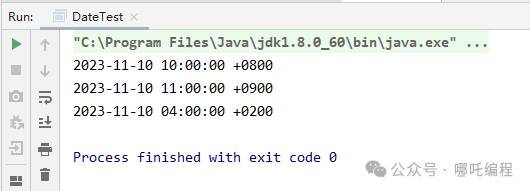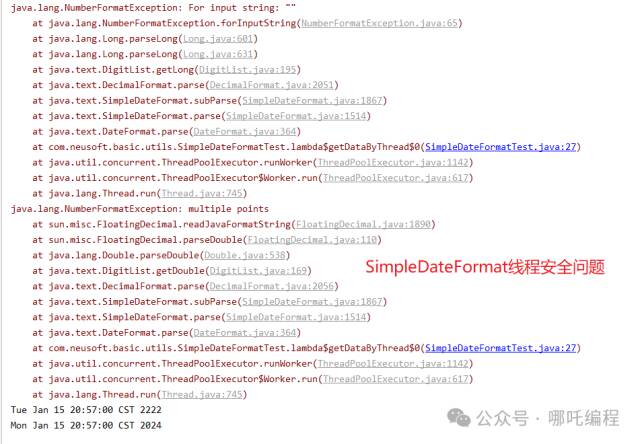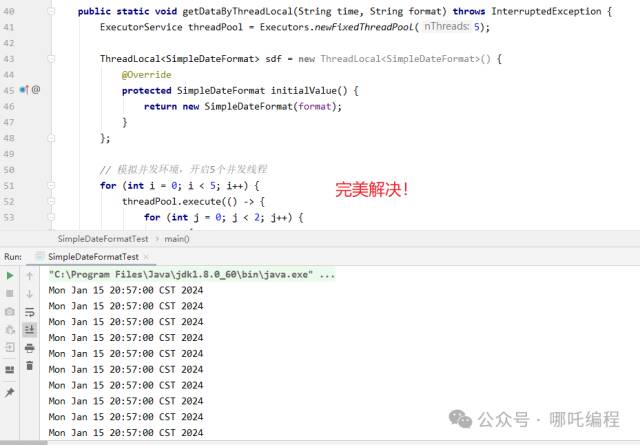写了这么多年DateUtils,殊不知你还有这么多弯弯绕!
创始人
2025-07-12 18:01:43
0次

大家好,我是哪吒。
public static Date getData(String date) throws ParseException {
SimpleDateFormat sdf = new SimpleDateFormat("yyyy-MM-dd HH:mm:ss");
return sdf.parse(date);
}
public static Date getDataByFormat(String date, String format) throws ParseException {
SimpleDateFormat sdf = new SimpleDateFormat(format);
return sdf.parse(date);
}你应该听过“时区”这个名词,大家也都知道,相同时刻不同时区的时间是不一样的。
因此在使用时间时,一定要给出时区信息。
public static void getDataByZone(String param, String format) throws ParseException {
SimpleDateFormat sdf = new SimpleDateFormat(format);
// 默认时区解析时间表示
Date date = sdf.parse(param);
System.out.println(date + ":" + date.getTime());
// 东京时区解析时间表示
sdf.setTimeZone(TimeZone.getTimeZone("Asia/Tokyo"));
Date newYorkDate = sdf.parse(param);
System.out.println(newYorkDate + ":" + newYorkDate.getTime());
}
public static void main(String[] args) throws ParseException {
getDataByZone("2023-11-10 10:00:00","yyyy-MM-dd HH:mm:ss");
}对于当前的上海时区和纽约时区,转化为 UTC 时间戳是不同的时间。
对于同一个本地时间的表示,不同时区的人解析得到的 UTC 时间一定是不同的,反过来不同的本地时间可能对应同一个 UTC。

public static void getDataByZoneFormat(String param, String format) throws ParseException {
SimpleDateFormat sdf = new SimpleDateFormat(format);
Date date = sdf.parse(param);
// 默认时区格式化输出
System.out.println(new SimpleDateFormat("[yyyy-MM-dd HH:mm:ss Z]").format(date));
// 东京时区格式化输出
TimeZone.setDefault(TimeZone.getTimeZone("Asia/Tokyo"));
System.out.println(new SimpleDateFormat("[yyyy-MM-dd HH:mm:ss Z]").format(date));
}
public static void main(String[] args) throws ParseException {
getDataByZoneFormat("2023-11-10 10:00:00","yyyy-MM-dd HH:mm:ss");
}我当前时区的 Offset(时差)是 +8 小时,对于 +9 小时的纽约,整整差了1个小时,北京早上 10 点对应早上东京 11 点。

Java 8 推出了新的时间日期类 ZoneId、ZoneOffset、LocalDateTime、ZonedDateTime 和 DateTimeFormatter,处理时区问题更简单清晰。
public static void getDataByZoneFormat8(String param, String format) throws ParseException {
ZoneId zone = ZoneId.of("Asia/Shanghai");
ZoneId tokyoZone = ZoneId.of("Asia/Tokyo");
ZoneId timeZone = ZoneOffset.ofHours(2);
// 格式化器
DateTimeFormatter dtf = DateTimeFormatter.ofPattern(format);
ZonedDateTime date = ZonedDateTime.of(LocalDateTime.parse(param, dtf), zone);
// withZone设置时区
DateTimeFormatter dtfz = DateTimeFormatter.ofPattern("yyyy-MM-dd HH:mm:ss Z");
System.out.println(dtfz.withZone(zone).format(date));
System.out.println(dtfz.withZone(tokyoZone).format(date));
System.out.println(dtfz.withZone(timeZone).format(date));
}
public static void main(String[] args) throws ParseException {
getDataByZoneFormat8("2023-11-10 10:00:00","yyyy-MM-dd HH:mm:ss");
}- Asia/Shanghai对应+8,对应2023-11-10 10:00:00。
- Asia/Tokyo对应+9,对应2023-11-10 11:00:00。
- timeZone 是+2,所以对应2023-11-10 04:00:00。

- 通过ZoneId,定义时区;
- 使用ZonedDateTime保存时间;
- 通过withZone对DateTimeFormatter设置时区;
- 进行时间格式化得到本地时间;
思路比较清晰,不容易出错。
百度一下,才知道是高并发情况下SimpleDateFormat有线程安全的问题。
下面通过模拟高并发,把这个问题复现一下:
public static void getDataByThread(String param, String format) throws InterruptedException {
ExecutorService threadPool = Executors.newFixedThreadPool(5);
SimpleDateFormat sdf = new SimpleDateFormat(format);
// 模拟并发环境,开启5个并发线程
for (int i = 0; i < 5; i++) {
threadPool.execute(() -> {
for (int j = 0; j < 2; j++) {
try {
System.out.println(sdf.parse(param));
} catch (ParseException e) {
System.out.println(e);
}
}
});
}
threadPool.shutdown();
threadPool.awaitTermination(1, TimeUnit.HOURS);
}果不其然,报错。还将2023年转换成2220年,我勒个乖乖。
在时间工具类里,时间格式化,我都是这样弄的啊,没问题啊,为啥这个不行?原来是因为共用了同一个SimpleDateFormat,在工具类里,一个线程一个SimpleDateFormat,当然没问题啦!

可以通过TreadLocal 局部变量,解决SimpleDateFormat的线程安全问题。
public static void getDataByThreadLocal(String time, String format) throws InterruptedException {
ExecutorService threadPool = Executors.newFixedThreadPool(5);
ThreadLocal sdf = new ThreadLocal() {
@Override
protected SimpleDateFormat initialValue() {
return new SimpleDateFormat(format);
}
};
// 模拟并发环境,开启5个并发线程
for (int i = 0; i < 5; i++) {
threadPool.execute(() -> {
for (int j = 0; j < 2; j++) {
try {
System.out.println(sdf.get().parse(time));
} catch (ParseException e) {
System.out.println(e);
}
}
});
}
threadPool.shutdown();
threadPool.awaitTermination(1, TimeUnit.HOURS);
} 
public class SimpleDateFormat extends DateFormat {
@Override
public Date parse(String text, ParsePosition pos){
CalendarBuilder calb = new CalendarBuilder();
Date parsedDate;
try {
parsedDate = calb.establish(calendar).getTime();
// If the year value is ambiguous,
// then the two-digit year == the default start year
if (ambiguousYear[0]) {
if (parsedDate.before(defaultCenturyStart)) {
parsedDate = calb.addYear(100).establish(calendar).getTime();
}
}
}
}
}
class CalendarBuilder {
Calendar establish(Calendar cal) {
boolean weekDate = isSet(WEEK_YEAR)
&& field[WEEK_YEAR] > field[YEAR];
if (weekDate && !cal.isWeekDateSupported()) {
// Use YEAR instead
if (!isSet(YEAR)) {
set(YEAR, field[MAX_FIELD + WEEK_YEAR]);
}
weekDate = false;
}
cal.clear();
// Set the fields from the min stamp to the max stamp so that
// the field resolution works in the Calendar.
for (int stamp = MINIMUM_USER_STAMP; stamp < nextStamp; stamp++) {
for (int index = 0; index <= maxFieldIndex; index++) {
if (field[index] == stamp) {
cal.set(index, field[MAX_FIELD + index]);
break;
}
}
}
...
}
}- 先new CalendarBuilder()。
- 通过parsedDate = calb.establish(calendar).getTime();解析时间。
- establish方法内先cal.clear(),再重新构建cal,整个操作没有加锁。
上面几步就会导致在高并发场景下,线程1正在操作一个Calendar,此时线程2又来了。线程1还没来得及处理 Calendar 就被线程2清空了。
因此,通过编写Date工具类,一个线程一个SimpleDateFormat,还是有一定道理的。
相关内容
热门资讯
如何允许远程连接到MySQL数...
[[277004]]【51CTO.com快译】默认情况下,MySQL服务器仅侦听来自localhos...
如何利用交换机和端口设置来管理...
在网络管理中,总是有些人让管理员头疼。下面我们就将介绍一下一个网管员利用交换机以及端口设置等来进行D...
各种千兆交换机的数据接口类型详...
千兆交换机有很多值得学习的地方,这里我们主要介绍各种千兆交换机的数据接口类型,作为局域网的主要连接设...
施耐德电气数据中心整体解决方案...
近日,全球能效管理专家施耐德电气正式启动大型体验活动“能效中国行——2012卡车巡展”,作为该活动的...
Windows恶意软件20年“...
在Windows的早期年代,病毒游走于系统之间,偶尔删除文件(但被删除的文件几乎都是可恢复的),并弹...
规避非法攻击 用好路由器远程管...
单位在市区不同位置设立了科技服务点,每一个服务点的员工都通过宽带路由器进行共享上网,和单位网络保持联...
范例解读VB.NET获取环境变...
VB.NET编程语言的使用范围非常广泛,可以帮助开发人员处理各种程序中的需求,而且还能对移动设备进行...
20个非常棒的扁平设计免费资源
Apple设备的平面图标PSD免费平板UI 平板UI套件24平图标Freen平板UI套件PSD径向平...